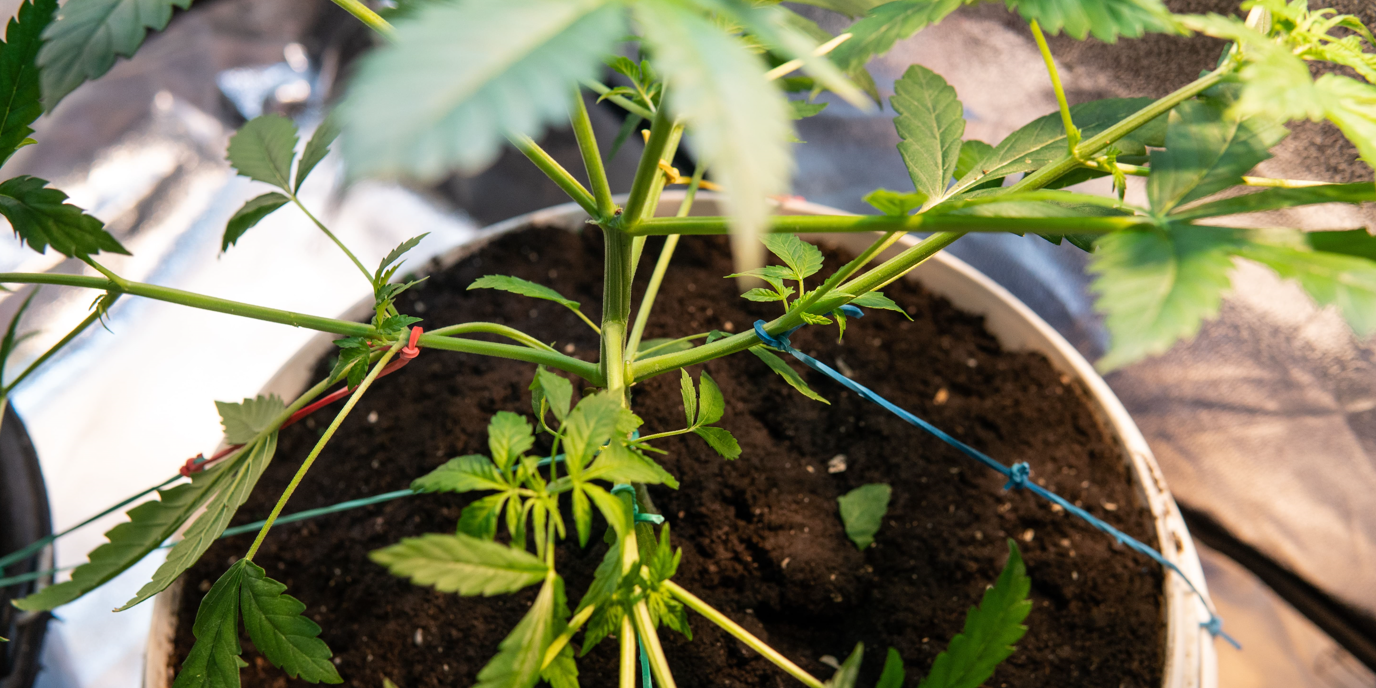What is Low-Stress Training (LST) and Why It’s Beneficial
Low-stress training (LST) is a method of gradually manipulating the growth and structure of plants. This includes techniques such as tying, bending, topping, and wiring branches to produce more desirable shapes or volumes.
It's commonly paired with the SCROG growing method (screen of green).
Why would someone do this? The philosophy is that plants respond better to gentle guidance and stress. Similar to bonsai, low-stress training can be used to shape a plant in the desired way and increase yields while minimizing stress.
With this guide, we'll be covering step-by-step how to perform low-stress training on cannabis plants.
Through low-stress training, home and commercial growers can control the direction in which a plant grows and shape it so that it produces bigger buds, increases yields, and has improved aeration to reduce the chances of mold or mildew.
If you prefer visual content check out our YouTube channel here.
Table of Contents
When to Start LST and When to Expect Results
In the many years I've spent growing cannabis I've identified the optimal time to initiate low-stress training is during the vegetative stage of your plants, after they have developed several strong nodes.
That’s the point where they will have enough strength in the branches and stems to hold up under manipulation. It also gives you plenty of time to work with the plants since flowering will typically begin 6-8 weeks after.
You can expect results within a couple of weeks, but it’s important to inspect your plants and adjust the training methods if needed.
After about a month, you should be able to see a clear difference between plants that have been trained, and those that have not.
Low Stress Training Diagram (Step-by-Step)

To follow the steps for low stress training step by step, you can check out this diagram or read more below.
Step 1: Choose the Branch or Stem to Train
Take a look at your plant and identify which branches or stems you want to train. The best candidates are those that are long, fairly straight, and with plenty of leaves.
You can also spread the training across multiple branches or stems to evenly distribute the stress and get good results.
Step 2: Tie Down the Branch/Stem
Tie down the branch/stem you’ve chosen for training using a soft material such as twine or a soft tie. Make sure to leave plenty of slack and that the knots aren’t too tight.
You may also want to attach weights such as stones, coins, or other heavy objects to bend the branch/stem. This is an optional step so you can experiment with it if desired.
Step 3: Monitor and Adjust
Once you’ve tied down the branch/stem, give it some time and observe. You may want to adjust the tie or weights if needed to get the desired shape.
Step 4: Repeat
Repeat this process as many times as needed until your plants are shaped in the way that you desire. Keep in mind that low-stress training can take some time, so be patient and gentle with your plant while you work on it.
Low Stress Training Time-Lapse
Low stress training time-lapses are incredibly useful tools for seeing firsthand how different environmental conditions affect plant growth.
From light intensity and temperature levels to humidity levels and nutrient availability, these variables all play a role in determining how successful crops will be both in terms of yield and quality.
With LST time-lapses, you can track every aspect of your grow’s performance easily so that any necessary adjustments can be made sooner rather than later - ensuring maximum crop production with minimal effort!
Tips for Getting the Most Out of LST Growing
Low-stress training can be a great way to maximize yield and optimize your growing space. Here are some tips for getting the most out of your training:
• Start early in the growth cycle so you have time to make adjustments
• Tie or wire branches gently, without straining them too much
• Monitor plants regularly to adjust ties and weights as needed
• Be patient - results won’t show up right away
• Don’t over-train your plants, as the stress can be harmful
Whether it's your 1st grow or 100th, you'll notice a sizable difference in cola size and yield by following low-stress training techniques.
Now that we've talked about tips for success with LST, let's discuss some common mistakes.
Common Mistakes in Low-Stress Straining and How to Avoid Them
Like any gardening activity, there can be some mistakes made in LST when you’re first getting started. Here are some common mistakes and how to avoid them:
Not Starting Early Enough
Start training your plants as soon as they reach 3 weeks old so you have plenty of time to adjust the ties and weights. Otherwise, you may not have enough time to get the desired shape before flowering begins.
Using Too Much Force
When tying or wiring branches, be gentle and use as little force as possible. If the ties are too tight it can hinder plant growth and even cause damage to the stems.
Not Monitoring Regularly
Be sure to monitor the plants regularly and adjust ties and weights as needed. This will ensure that your plants are getting the desired shape without any strain or damage.
Final Tips for Successful Low-Stress Training

Low-stress training can be a great way to increase yields and optimize your growing space. Just remember to start early, go slow, and keep an eye on your plants while they’re growing.
With consistent monitoring and gentle manipulation, you should be able to get huge yields with minimal stress to your plants. Good luck!









